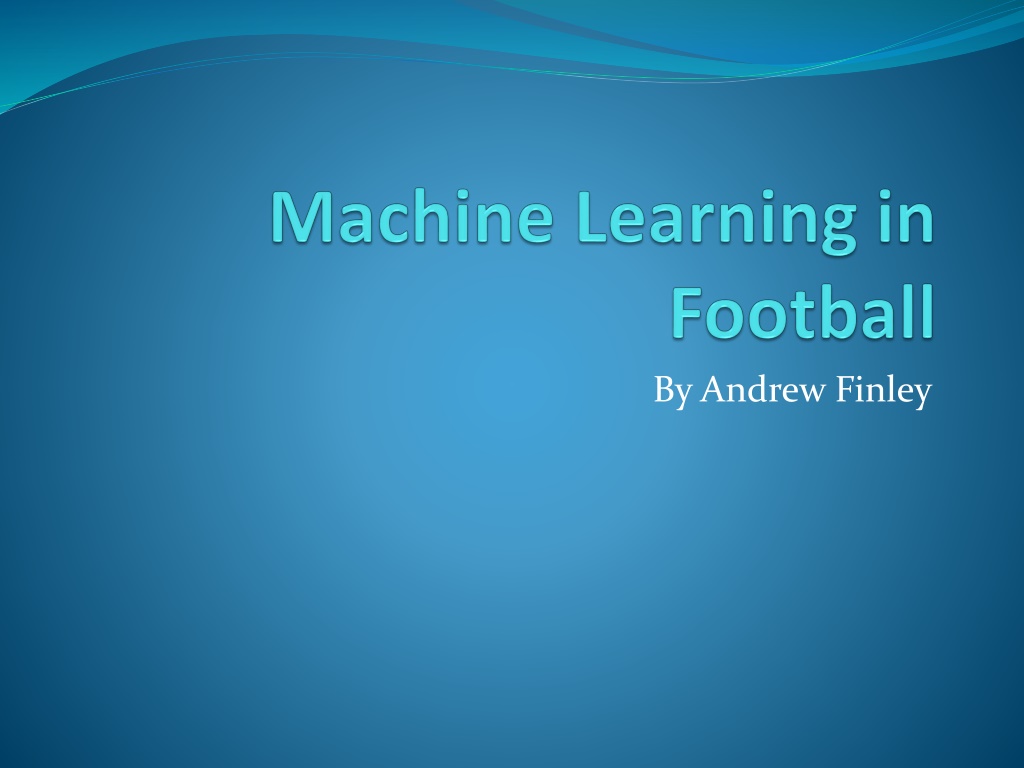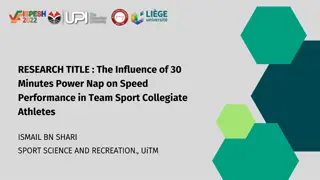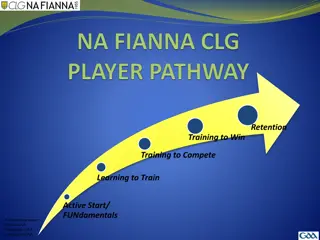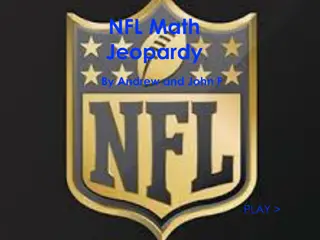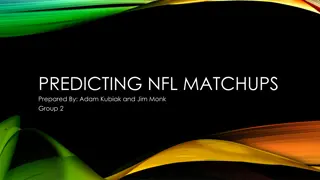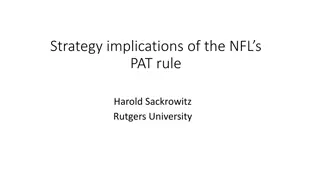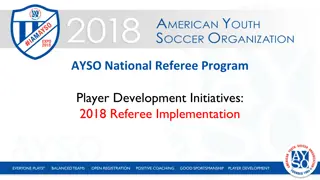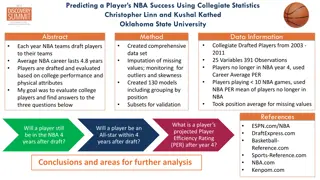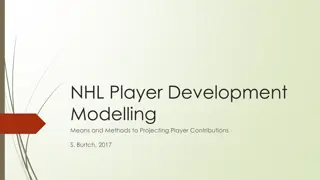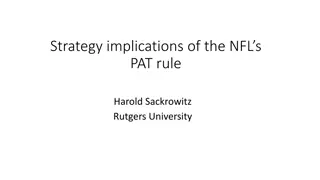Predicting NFL Player Performance Based on Collegiate Statistics
Research explores the feasibility of predicting a football player's professional success using their collegiate performance. By gathering and analyzing statistics from NCAA and NFL players and employing machine learning algorithms such as Decision Trees, the study aims to predict NFL statistics from collegiate data to reduce the number of draft busts. The approach involves classifying players into QBs and RBs, considering individual and team stats, rankings, and physical attributes for predictions. Related works and the use of Decision Trees in supervised learning are also discussed for insight.
Download Presentation

Please find below an Image/Link to download the presentation.
The content on the website is provided AS IS for your information and personal use only. It may not be sold, licensed, or shared on other websites without obtaining consent from the author. Download presentation by click this link. If you encounter any issues during the download, it is possible that the publisher has removed the file from their server.
E N D
Presentation Transcript
Research Question Is it possible to predict a football player s professional based on collegiate performance? That is, is it possible to accurately predict some player s NFL statistic using only their collegiate statistics? Why Too many busts How Gather statistics for both NCAA and NFL players Use statistics and ML algorithms to train a program Use program to predict unseen examples
Presentation Outline Related Works Alternate applications of machine learning in sport My Approach Machine Learning - Classification Decision Tree Algorithm Implementation Statistics to predict Gather and Format Statistics Insert into Weka (ML software) Build Decision Tree Results and Analysis Cross-validation Feature Selection
Related Works Mr. NFL/NCAA (Predicts Games) Classification using Linear Regression on Team Statistics FFtoday.com (Predicts Fantasy Football Stats) Linear Regression on Fantasy Football Statistics Draft Tek (Predicts NFL Draft) Ranks college players and takes a matrix of team needs at every position SABRmetrics Use statistical analysis to create new baseball statistics Example: RUNS = (.41) 1B + (.82) 2B + (1.06) 3B + (1.42) HR
Machine Learning Type Supervised Learning (Classification) Program is given a set of examples (instances) from which it learns to classify unseen examples Each instance is a set of attribute values and with a known class The goal is to generate a set of rules that will correctly classify new examples Algorithm: Decision Tree
Decision Tree Create a graph (tree) from the training data. The leaves are the classes, and branches are attribute values Goal is to make the smallest tree possible that covers all instances Use the tree to make a set of classification rules
My Data I narrowed my predictions down to just Quarterbacks and Running backs Input (NCAA): Individual and team stats from every year of college play, as well as team rankings and strength of schedule, and height and weight Combine data not included due to lack of participation Output (NFL): RB: Yrds/Carry, Total Rushing Yards, and Rushing TDs, for each of first 3 seasons, starting after 3 seasons QB: Total Passing Yards, Passing TDs, Interceptions, and QB Rating, for each of first 3 seasons, starting after 3 seasons
Data Retrieval Step 1 Find statistics Online: NFL.com, NCAA.org Collegio Football: Database Software Step 2 Extract data Python scripts parsed necessary statistics off websites Statistics from Collegio were exported manually Step 3 Convert data into correct format Python scripts used to combine data into 2 large .csv files for, one for RB and one for QB Missing data is filled in as accurately as possible
Example Player School Year1 Pos1 Cl1 G1 Rush Yds1 Car1 Rush TD1 Yds/Car1 RushYds/G1 Rec Yds1 Rec1 Rec TD1 Yds/Rec1 Rec/G1 RecYds/G1 PR1 PR Yds1 PR TD1Yds/PR1 PR/G1 KR1 KR Yds1 KR TD1Yds/KR1 KR/G1 Ret TD1 Tot Yds1 Tot TD1 TotYds/G1 Ronnie BrownAuburn 2002RB So 12 1008 175 13 5.76 84 166 9 1 18.4 0 13.8 0 0 0 0 0 0 0 0 0 0 0 1174 14 97.8 Year2 Pos2 Cl2 G2 Rush Yds2 Car2 Rush TD2 Yds/Car2 RushYds/G2 Rec Yds2 Rec2 Rec TD2 Yds/Rec2 Rec/G2 RecYds/G2 PR2 PR Yds2 PR TD2Yds/PR2 PR/G2 KR2 KR Yds2 KR TD2Yds/KR2 KR/G2 Ret TD2 Tot Yds2 Tot TD2 TotYds/G2 2003RB Jr 6 446 95 5 4.7 74.3 80 8 0 10 1 13.3 0 0 0 0 0 0 0 0 0 0 0 526 5 87.6 Year3 Pos3 Cl3 G3 Rush Yds3 Car3 Rush TD3 Yds/Car3 RushYds/G3 Rec Yds3 Rec3 Rec TD3 Yds/Rec3 Rec/G3 RecYds/G3 PR3 PR Yds3 PR TD3Yds/PR3 PR/G3 KR3 KR Yds3 KR TD3Yds/KR3 KR/G3 Ret TD3 Tot Yds3 Tot TD3 TotYds/G3 2004RB Sr 12 913 153 8 5.97 76.1 313 34 1 9.2 2 26.1 0 0 0 0 0 0 0 0 0 0 0 1226 9 102.2 Height Weight 6'-1'' 230 Season1 Team1 G1 GS1 Att1 RushYds1 RushAvg1 RushLng1 RushTD1 Rec1 RecYds1 RecAvg1 RecLng1 RecTD1 FUM1 Lost1 Starting 2005MiamiDolphins 15 14 207 907 4.4 65 4 32 232 7.3 38 1 4 4 TRUE Season2 Team2 G2 GS2 Att2 RushYds2 RushAvg2 RushLng2 RushTD2 Rec2 RecYds2 RecAvg2 RecLng2 RecTD2 FUM2 Lost2 Starting 2006MiamiDolphins 13 12 241 1008 4.2 47 5 33 276 8.4 24 0 4 2 TRUE Season3 Team3 G3 GS3 Att3 RushYds3 RushAvg3 RushLng3 RushTD3 Rec3 RecYds3 RecAvg3 RecLng3 RecTD3 FUM3 Lost3 Starting 2007MiamiDolphins 7 7 119 602 5.1 60 4 39 389 10 43 1 0 0 TRUE Blue = NCAA data Red = NFL data
Weka Data Processing Weka is a machine learning algorithm database built in Java. Only accepts .csv files in particular format. Preprocessing: Apply filters to fix missing stats Remove all NFL data except statistic being predicted Classify the desired statistic: if numeric separate into ranges, if nominal separate by values. Specify attributes
Building the Tree Tree is constructed from specified attributes. Weka converts tree to classification rules. Accuracy is measured using cross validation. Cross validation: Break the training data into a specified number of sets, use each set once as the test data, while the rest is used as training data.
Initial Results Initial runs with all attributes used failed; created a 1 layer tree mapped to false for predicted statistic. The accuracy varies greatly with slight changes to attributes used. Tree size seems to increase as the attributes used decreases.
Analysis The initial 1 layer tree that was built gave an accuracy of 68%. This is the worst possible tree, so I should be able to get accuracy better than this. Attribute selection needs to improve.
Next Improve attribute selection to optimize accuracy. (If time) Implement other algorithms to compare accuracy.
